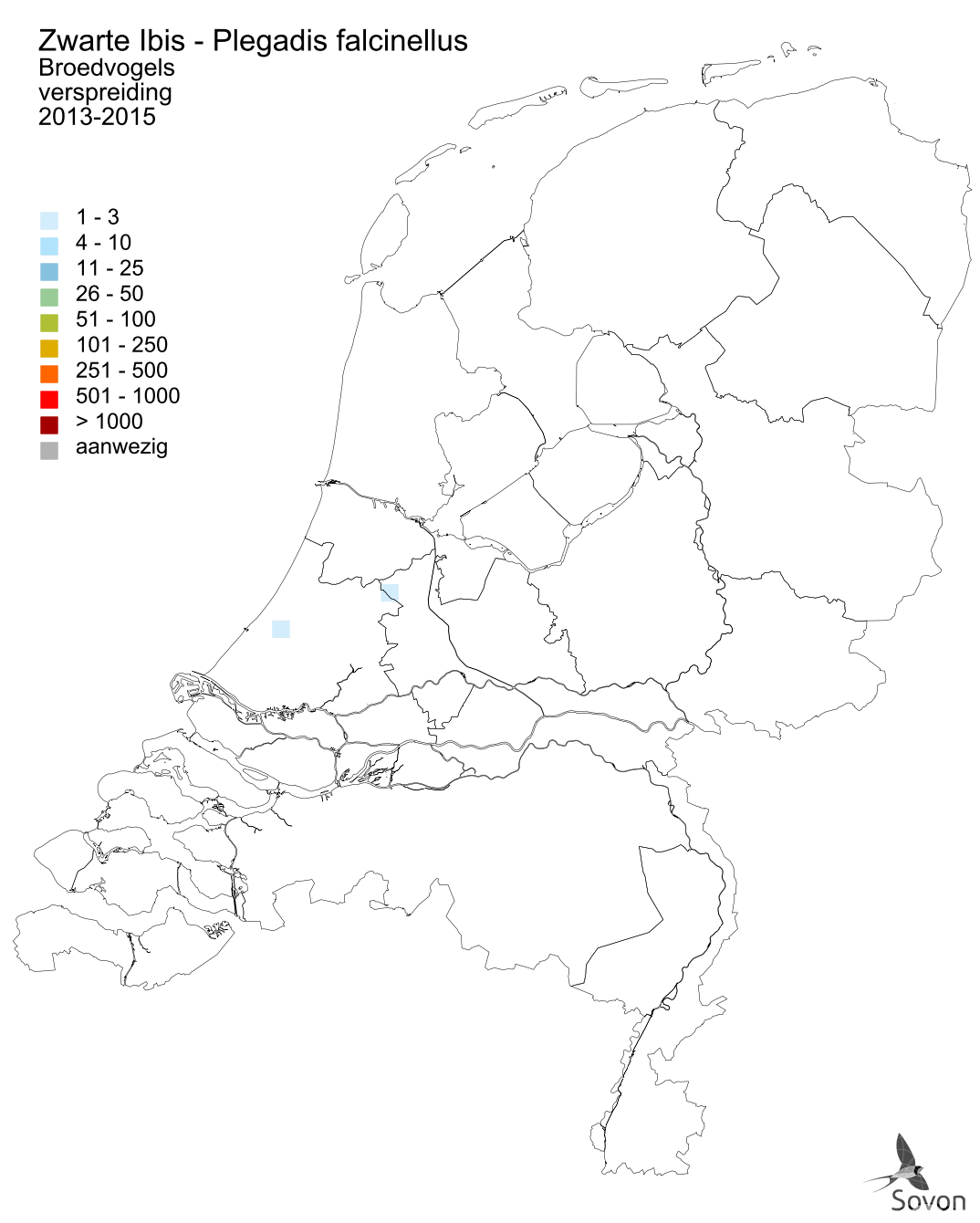Verspreiding en trends
Verspreiding

Deze kaart is gebaseerd op de Vogelatlas van Nederland (Sovon 2018). Per atlasblok van 5x5 km is er een schatting van het aantal broedparen gegeven.

Deze kaart is gebaseerd op de Vogelatlas van Nederland (Sovon 2018). Per atlasblok van 5x5 km is er een schatting van het aantal individuen gegeven.
Aantalsontwikkeling
Onvoldoende gegevens beschikbaar voor trendanalyse.
Broedsucces en overleving
Onvoldoende gegevens beschikbaar voor trendanalyse.
Seizoensvoorkomen
seizoenspatroon
Deze gegevens zijn gebaseerd op losse waarnemingen uit het Bijzondere Soorten Project (BSP)
Beschrijving voorkomen
Buiten broedtijd
De Zwarte ibis was tot 1990 zeldzaam in Nederland. Sindsdien neemt de soort in aantal toe. De Zwarte Ibissen die in ons land verschijnen, zullen tegenwoordig hoofdzakelijk afkomstig zijn uit Zuid-Europa (met name Spanje), in het verleden ook uit Zuidoost-Europa (Hongarije). Het jaarlijkse voorkomen is erg wisselvallig, met in sommige jaren een influx zoals in 1932 en 1994. Na de eeuwwisseling is het voorkomen regelmatiger geworden.. De soort kan het hele jaar worden gezien, met een kleine voorjaarspiek in april-juni en een duidelijkere najaarspiek in september-november. De meeste waarnemingen stammen uit West- en Noord-Nederland.
Broedtijd
Ondanks waarnemingen van met takjes slepende, baltsende en parende vogels zijn er nog geen zekere broedgevallen bekend. Toekomstig broeden is niet onmogelijk, gezien de sterke opmars van Zwarte Ibissen in Zuid-Europa. Waarnemingen werden tot en met 1999 beoordeeld door de Commissie Dwaalgasten Nederlandse Avifauna en daarna geregistreerd door Sovon en Waarneming.nl.
Vogelrichtlijn
Staat van instandhouding
De Vogelrichtlijn richt zich op de instandhouding van alle natuurlijk in Europa in het wild levende vogelsoorten waaronder de Zwarte Ibis.
Dit betekent dat de EU-lidstaten maatregelen moeten nemen om de populaties van deze soorten op een niveau te houden of te brengen dat met name beantwoordt aan de ecologische, wetenschappelijke en culturele eisen. Daaronder wordt onder andere een gunstige staat van instandhouding verstaan. Het begrip Staat van instandhouding is zo ongeveer synoniem voor de mate van duurzaamheid of gezondheid van een populatie van een soort.
De Vogelrichtlijn verlangt van de lidstaten dat ze leefgebieden voor vogels in voldoende omvang en kwaliteit in stand houden, waaronder door de aanwijzing van speciale beschermingszones ten behoeve van het Europese Natura 2000-netwerk. Voor de Zwarte Ibis zijn in Nederland geen speciale beschermingszones aangewezen. De landelijke populatie moet zich wel op een gunstig niveau kunnen handhaven.
Methodiek voor de bepaling van de Staat van instandhouding van vogels
niet-broedvogel
De Staat van Instandhouding van de Zwarte Ibis als niet-broedvogel in Nederland is gunstig.
| Beoordeling Staat van Instandhouding | ||||
| Verspreiding | Populatie | Leefgebied | Toekomst | Eindoordeel |
| gunstig | gunstig | gunstig | gunstig | gunstig |
Aangewezen gebieden
Er zijn geen gebieden aangewezen voor deze soort.
Telrichtlijnen
Er zijn geen telrichtlijnen voor deze soort.
